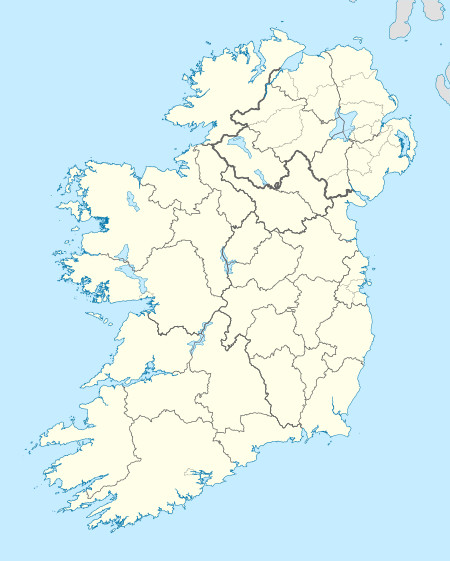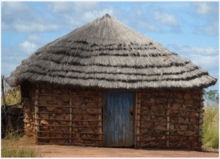Skellig Michael
| Native name: <span class="nickname" ">Sceilig Mhichíl | |
|---|---|
|
Monastery in Skellig Michael | |
 Skellig Michael | |
| Geography | |
| Location | Atlantic Ocean |
| Area | 21.9 ha (54 acres)[1] |
| Highest elevation | 218 m (715 ft)[2] |
| Administration | |
|
Republic of Ireland | |
| County | Kerry |
| Demographics | |
| Population | 0 |
| Type | Cultural |
| Criteria | iii, iv |
| Designated | 1996 (20th session) |
| Reference no. | 757 |
| State Party | Ireland |
| Region | Europe and North America |
Skellig Michael (Irish: Sceilig Mhichíl), also called Great Skellig (Irish: Sceilig Mhór), is the larger of the two Skellig Islands, 11.6 kilometres (7.2 mi) west of the Iveragh peninsula in County Kerry, Ireland.[2] A Christian monastery was founded on the island at some point between the 6th and 8th century and remained continuously occupied until it was abandoned in the late 12th century. The remains of the monastery, and most of the island, became a UNESCO World Heritage Site in 1996.[2]
History
Pre-monastic
Skellig Michael was uninhabited before its monastery was founded.[2] Folklore holds that Ir, son of Míl Espáine, was buried on the island, and a text from the 8th or 9th century states that Duagh, King of West Munster, fled to "Scellecc" after a feud with the Kings of Cashel, although it is not known whether these events actually took place.[3]
Monastic
The monastery's exact date of foundation is not known.[3] The first definite reference to monastic activity on the island is a record of the death of "Suibhini of Skelig" dating from the 8th century; however, Saint Fionán is claimed to have founded the monastery in the 6th century.
The monastic site on the island is on a terraced shelf 600 feet (180 metres) above sea level, and developed between the sixth and eighth centuries. It contains six beehive cells, two oratories as well as a number of stone crosses and slabs. It also contains a later medieval church. The cells and oratories are all of dry-built corbel construction. A carefully designed system for collecting and purifying water in cisterns was developed. It has been estimated that no more than twelve monks and an abbot lived here at any one time.[4] A hermitage is on the south peak.
The diet of monks living on the North Atlantic islands was somewhat different from that of those who lived on the mainland. With less arable land available to grow grain, vegetable gardens became an important part of monastic life. Of necessity, fish and the meat and eggs of birds nesting on the islands became staples.[5]
The "Annals of Inisfallen" record a Viking attack in 823. The site had been dedicated to Saint Michael by at least 1044 (when the death of "Aedh of Scelic-Mhichí" is recorded).[1][3] However, this dedication may have occurred as early as 950, around which time a new church was added to the monastery (typically done to celebrate a consecration) which was called Saint Michael's Church.[2]
The monastery remained continuously occupied until the 12th or 13th century.[2] During this time, the climate around Skellig Michael became colder and more prone to storms, and this, along with changes to the structure of the Irish Church, prompted the community to abandon the island and move to the abbey in Ballinskelligs.[3]
Post-monastic
Skellig Michael remained in the possession of the Catholic Canons Regular until the dissolution of the Ballinskelligs abbey during the Protestant Reformation by Elizabeth I in 1578.[2][6] Ownership was then passed to the Butler family with whom it stayed until the early 1820s, when the Corporation for Preserving and Improving the Port of Dublin (the predecessor to the Commissioners of Irish Lights) purchased the island from John Butler of Waterville in a compulsory purchase order.[3][6] The Corporation constructed two lighthouses on the Atlantic side of the island, and associated living quarters, all of which was completed by 1826.[1] The Office of Public Works took the remains of the monastery into guardianship in 1880, and repaired certain collapsed structures, before buying the island (with the exception of the lighthouses and associated structures) from the Commissioners of Irish Lights.[1][2][3]
World Heritage listing

Skellig Michael was made a World Heritage Site in 1996, at the 20th Session of the World Heritage Committee in Mérida, Mexico.[7] After being nominated for inclusion on 28 October 1995, an evaluation of the site by the International Council on Monuments and Sites (an advisory body of the World Heritage Committee), recommended that the island be inscribed on the basis of criteria (iii) and (iv) of the World Heritage List's selection criteria, which relate the cultural significance of a site.[6] The Committee approved this recommendation, describing Skellig Michael as of "exceptional universal value", and a "unique example of an early religious settlement", while also noting the site's preservation as a result of its "remarkable environment", and its ability to illustrate "as no other site can, the extremes of a Christian monasticism characterizing much of North Africa, the Near East and Europe".[7]
Demographics
| Historical population | ||||||||||||||||||||||||||||||||||||||||||||||||||||||||||||||||||||||||||||||||
|---|---|---|---|---|---|---|---|---|---|---|---|---|---|---|---|---|---|---|---|---|---|---|---|---|---|---|---|---|---|---|---|---|---|---|---|---|---|---|---|---|---|---|---|---|---|---|---|---|---|---|---|---|---|---|---|---|---|---|---|---|---|---|---|---|---|---|---|---|---|---|---|---|---|---|---|---|---|---|---|---|
|
|
| ||||||||||||||||||||||||||||||||||||||||||||||||||||||||||||||||||||||||||||||
| Source: Central Statistics Office. "CNA17: Population by Off Shore Island, Sex and Year". CSO.ie. Retrieved October 12, 2016. | ||||||||||||||||||||||||||||||||||||||||||||||||||||||||||||||||||||||||||||||||
Access and activities
Each year at least four boat licences are granted to tour operators[8] who run trips to Skellig Michael during the summer season (May to October, inclusive), weather permitting. For safety reasons, because the steps up to the monastery are rocky, steep, and old, climbs are not permitted during very wet or windy weather. There are dive sites immediately around the rock.[9]
Popular culture
- The acclaimed 1969 BBC documentary Civilisation: A Personal View by Kenneth Clark featured a short segment on the use of Skellig Michael in the first episode.
- Skellig Michael is featured in the second episode of the BBC documentary series A History of Christianity.
- The island served as a location for the final scene in Heart of Glass by Werner Herzog.
- The island served as a filming location for the final scene of Star Wars: The Force Awakens.[10][11] It was also used for the next film in the series, Star Wars: Episode VIII.[12] This caused concerns[13] because of the significance of the site as a special protection area[14] for its colonies of puffins, Manx shearwaters and storm petrels.
- Skellig Michael is a major influence on the fictional Skellige in the award-winning video game series The Witcher, which features similar landmarks and islands, and the inhabitants of which share a culture and accent with that of the Gaels.
See also
- List of abbeys and priories in Ireland (County Kerry)
- List of World Heritage Sites in the Republic of Ireland
References
- 1 2 3 4 Edward Bourke; Alan R. Hayden; Ann Lynch. "Skellig Michael Co. Kerry: the monastery and South Peak" (PDF). Department of Arts, Heritage and the Gaeltacht. Retrieved 28 Dec 2015.
- 1 2 3 4 5 6 7 8 United Nations Educational, Scientific and Cultural Organization (UNESCO). "Skellig Michael". UNESCO. Retrieved 29 May 2012.
- 1 2 3 4 5 6 Department of Arts, Heritage and the Gaeltacht. "Skellig Michael: Historical Background". Department of Arts, Heritage and the Gaeltacht. Retrieved 29 May 2012.
- ↑ "Skellig", Diocese of Kerry
- ↑ Horn, Walter, Jenny White Marshall, and Grellan D. Rourke The Forgotten Hermitage of Skellig Michael, Berkeley: University of California Press, 1990 ISBN 978-0520064102
- 1 2 3 International Council on Monuments and Sites (October 1996). "World Heritage List: Skellig Michael" (PDF). International Council on Monuments and Sites. Retrieved 31 May 2012.
- 1 2 World Heritage Committee (10 March 1997). "Convention Concerning the World Cultural and Natural Heritage" (PDF). United Nations Educational, Scientific and Cultural Organization. p. 68. Retrieved 31 May 2012.
- ↑ , Public Competition for a Permit to carry passengers to Skellig Michael
- ↑ "Diving around Skellig Michael" Ballinskelligs Watersports, http://www.skelligboats.com/diving.htm, accessed 27 October 2010
- ↑ O'Sullivan, Majella (29 July 2014). "And . . . action! New 'Star Wars' film shoot kicks off on Skellig Michael". Irish Independent. Independent News & Media. Retrieved 29 November 2014.
- ↑ Gettell, Oliver (4 January 2016). "JJ Abrams can't believe he got to shoot on Skellig Michael". Entertainment Weekly. Retrieved 6 January 2016.
- ↑ Breznican, Anthony (9 September 2015). "Updated: Star Wars: Episode VIII will shoot in Ireland this month". Entertainment Weekly. (Entertainment Weekly). Retrieved 9 September 2015.
- ↑ Siggins, Lorna (13 February 2016). "Concern over 'incidents' during 'Star Wars' filming on Skellig Michael". IrishTimes.com. Irish Times. Retrieved 15 February 2016.
- ↑ "National Parks & Wildlife Service". National Parks & Wildlife Service.
External links
| Wikivoyage has a travel guide for Skellig Michael. |
![]() Media related to Skellig Michael at Wikimedia Commons
Media related to Skellig Michael at Wikimedia Commons
Coordinates: 51°46′16″N 10°32′26″W / 51.77111°N 10.54056°W
.jpg)
